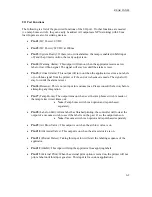
MACHINE TERMS
Label Placement
: The time from when the product sensor is made to when the labeling sequence
starts.
Label Sensor
: The sensor that detects the leading or trailing edge of the label.
Label Size
: The width and length (or feed) of a label. Length equals the distance from the leading
edge of the label to its trailing edge. Width is the distance across the label.
Leading Edge:
Refers to the signal sent from a sensor when the first edge of a product or label is
detected.
LED
: Light Emitting Diode
Normal Tamp Blow
: A mode of operation where a label is dispensed onto the label pad and the
applicator waits for the product detect sensor to turn on before starting the labeling sequence.
Parity
: A data bit that provides a means of checking for errors in the data stream.
Peel Edge
: A machined part just before the label pad used to transfer the label onto the pad as the
liner is pulled around the part.
Rewind
: This is the rotating mandrel that takes up the liner after the labels have been removed.
Static Stack
: When labels are applied to a stationary target on top of each other to check
repeatability of the applicator.
Tamp/Swing Extend Time
: The time allowed for the tamp slide to fully extend.
Tamp/Swing Retract Time
: The time allowed for the tamp slide to return from it’s extended
position to it’s retracted position.
Trailing Edge
: Refers to the signal sent from a sensor when the last edge of a product or a label
is detected.
Unwind
: The rotating mandrel where the roll of labels is placed to be printed and applied.
Valve Bank
: The typical valve bank for a tamp has three valves in it. Each valve has a built in
regulator and gauge. The assembly is made to be bolted on either side of the applicator.
Warning Alarm:
This alarm serves as a warning that the applicator is low on labels or ribbon.
Web Path
: The path the label liner follows leading from the unwind, through the printer and ends
at the rewind.
4-2
Summary of Contents for 3600-PA
Page 8: ......
Page 9: ......
Page 10: ......
Page 11: ......
Page 12: ......
Page 13: ......
Page 14: ......
Page 15: ......
Page 16: ......
Page 17: ......
Page 66: ......
Page 67: ......
Page 68: ......
Page 69: ......
Page 70: ......
Page 71: ......
Page 72: ......
Page 73: ......
Page 74: ......
Page 75: ......
Page 76: ......
Page 77: ......
Page 78: ......
Page 79: ......
Page 80: ......
Page 81: ......
Page 82: ......
Page 83: ......
Page 84: ......
Page 85: ......
Page 86: ......
Page 87: ......
Page 88: ......
Page 89: ......
Page 90: ......
Page 91: ......
Page 92: ......
Page 93: ......
Page 94: ......
Page 95: ......
Page 96: ......
Page 97: ......
Page 98: ......
Page 99: ......
Page 100: ......
Page 101: ......
Page 102: ......
Page 103: ......
Page 104: ......
Page 105: ......
Page 106: ......
Page 107: ......
Page 108: ......
Page 109: ......
Page 110: ......
Page 111: ......
Page 112: ......
Page 113: ......
Page 114: ......
Page 115: ......
Page 120: ......
Page 121: ......
Page 122: ......
Page 123: ......
Page 143: ......
Page 144: ......
Page 145: ......
Page 146: ......
Page 147: ......
Page 148: ......
Page 149: ......
Page 150: ......
Page 151: ......
Page 152: ......
Page 153: ......
Page 154: ......
Page 155: ......
Page 163: ...APPLY SEQUENCE Figure 28 c3 4 ...
Page 164: ......
Page 165: ......
Page 166: ......
Page 167: ......
Page 168: ......
Page 169: ......
Page 170: ......
Page 177: ......
Page 178: ......
Page 179: ......
Page 180: ......
Page 181: ......
Page 182: ......
Page 183: ......
Page 184: ......
Page 185: ......
Page 186: ......
Page 187: ......
















































